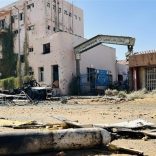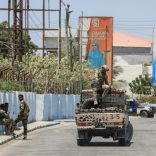Sudan volunteers shown beaten in video were among those later killed, Red Crescent says
Rwanda genocide: Nation marks 25 years since mass slaughter

African Union Commission Chairperson Moussa Faki Mahamat, Rwandan President Paul Kagame, Jeannette Kagame and European Commission President Jean-Claude Juncker, light the flame of hope during a commemoration ceremony of the 25th anniversary of the genocide at the Genocide Memorial in Gisozi in Kigali, Rwanda on April 7th, 2019. Photograph: Baz Ratner/Reuters
Commemorations have begun in Rwanda to mark the 25th anniversary of the genocide that killed about a tenth of the population.
The country will mourn for 100 days, the time it took in 1994 for 800,000 Rwandans to be massacred.
Most were minority Tutsis, killed by ethnic Hutu extremists.
President Paul Kagame, who led the rebel force that ended the genocide, lit a remembrance flame at the memorial in the capital, Kigali.
How is Rwanda remembering?
The commemoration activities began with the flame-lighting ceremony at the memorial, where about 250,000 victims are said to be buried. The flame will burn for 100 days.
The 61-year-old president, who has led the country since the end of the genocide, then delivered a speech at the Kigali Convention Centre.
He said the resilience and bravery of the genocide survivors represented the “Rwandan character in its purest form”.
“In 1994, there was no hope, only darkness. Today, light radiates from this place. How did it happen? Rwanda became a family once again,” Mr Kagame said.
President Paul Kagame has lit the flame of Remembrance assisted by a generation of 25 years at the @Kigali_Memorial. The flame will burn for the next 100 days for the 25th commemoration of the 1994 Genocide Against the Tutsi. #Kwibuk25 pic.twitter.com/SVKOsSvjyu
— Kwibuka Rwanda (@KwibukaRwanda) April 7, 2019
The president said the events had made the country more united.
“The fighting spirit is alive in us. What happened here will never happen again,” he said.
Mr Kagame will later lead a vigil at the Amahoro National Stadium, which was used by United Nations officials to try to protect Tutsis during the killings.
Who is attending?
A number of foreign leaders are in the country for the events. They are mainly African, although Prime Minister Charles Michel will represent the former colonial ruler, Belgium.
French President Emmanuel Macron will not be there. This week he appointed a panel of experts to investigate France’s role in the genocide.
France was a close ally of the Hutu-led government prior to the massacres and has been accused of ignoring warning signs and training the militias who carried out the attacks.
France will be represented by Herve Berville, a Rwandan-born MP.
Ugandan President Yoweri Museveni will also not be there. He has been accused of backing Rwandan rebels who oppose Mr Kagame.
The vast number of people attending are ordinary Rwandans, including those who lived through the slaughter.
Olive Muhorakeye, 26, told Reuters: “Remembering is necessary because it’s only thanks to looking back at what happened [can we] ensure that it never happens again.”
Carrying the scars
- The BBC’s Flora Drury in Kigali
At midday, Rwanda fell silent to remember the hundreds of thousands of men, women and children who lost their lives over 100 days in 1994.
But for survivors, the memories never fade. It might be a quarter of a century but it doesn’t feel like it. They still carry the scars, literally and figuratively, of those days.
They are still forced to explain to their children why they don’t have grandparents or aunts and uncles. They still dream of the horrors they witnessed.
So while today is important to remind the country and the world of what was lost 25 years ago – and the peace that has been achieved in the years since – it is clear that survivors need little reminding.
How did the genocide unfold?
On 6 April 1994, a plane carrying then-President Juvenal Habyarimana – a Hutu – was shot down, killing all on board.
Media captionBBC News reports show how the story of the genocide emerged
Hutu extremists blamed the Tutsi rebel group, the Rwandan Patriotic Front (RPF). It denied the accusation.
In a well-organised campaign of slaughter, militias were given hit lists of Tutsi victims. Many were killed with machetes in acts of appalling brutality.
One of the militias was the ruling party’s youth wing, the Interahamwe, which set up road blocks to find Tutsis, incited hatred via radio broadcasts and carried out house to house searches.
How did it end?
Little was done internationally to stop the killings. The UN and Belgium had forces in Rwanda but the UN mission was not given a mandate to act. The Belgians and most UN peacekeepers pulled out.

The RPF, backed by Uganda, started gaining ground and marched on Kigali. Some two million Hutus fled, mainly to the Democratic Republic of Congo.
The RPF was accused of killing thousands of Hutus as it took power, although it denies this.
Dozens of Hutus were convicted for their role in the killings by the International Criminal Tribunal for Rwanda, based in Tanzania, and hundreds of thousands more faced trial in community courts in Rwanda.
How is Rwanda now?
The genocide has cast a long shadow over regeneration and talk of ethnicity remains illegal.
But the country has recovered economically, with President Kagame’s policies encouraging rapid growth and technological advancement.
He won a third term in office in the most recent election in 2017 with 98.63% of the vote.
Growth remains good – 7.2% in 2018 according to the African Development Bank.
But Mr Kagame’s critics say he is too authoritarian and does not tolerate dissent.












Leave a Reply
Be the First to Comment!
You must be logged in to post a comment.
You must be logged in to post a comment.